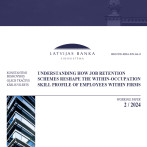Unemployment drop slows due to seasonality and changes in "100-lats" temporary jobs programme
Unemployment is dropping for the seventh consecutive quarter. Jobseekers rate in the fourth quarter of 2011 fell by 0.1 percentage point (to 14.3% of the economically active population), i.e. at a slower rate than before. This slower rate is related to the restructuring of the temporary jobs programme and the traditionally lower employment during the winter season. In December, with the completion of stage one of the temporary jobs or "100-lats" programme, no one took part in it. According to our calculations, this effect alone increased the proportion of jobseekers by 0.8 percentage points quarter-on-quarter. After the "empty" December, January was "half-empty" in terms of temporary work, for several local governments began implementing stage two of the temporary jobs programme only in February. Moreover, even as stage two of the programme accelerates to full speed, the number of participants will be substantially less than in stage one. Thus a lesser number of the employed in temporary jobs will have an increasing impact on unemployment (and decreasing to employment) also in the next few quarters.
The unemployment data react to the dynamics of economic activity with a delay, thus the slowdown in economic growth at the end of the year was not yet reflected in labour market data. According to the labour force survey data of the Central Statistical Bureau (CSB), the annual rise in the number of the employed reached a four-year maximum (3.7%). All available statistical data sources actually point to employment growth. For instance, according to the data on the number of social security payment makers of the State Revenue Service (does not include the shadow economy and the participants in stage one of temporary jobs programme), the number of employees in December grew 2.2% year-on-year.
The outlook of entrepreneurs on employment remained positive overall. Even though this indicator tends to fluctuate and the balance of the entrepreneurs' responses is only slightly above zero, European Commission data indicate that the excess of entrepreneurs expecting an increase in the number of their employees over those who plan to reduce the number of their employees in January 2012 reached an 11-month maximum in manufacturing (a 6-month maximum in retail). Negative expectations of employment are observed only in construction, which is in contrast with the hitherto rapid rise in employment in this branch. This phenomenon could stem from the prevalence of the shadow economy: i.e. only official businesses participate in business tendency surveys whereas the labour force survey data include also those who grant construction services unofficially.
Census results have yet to find reflection in the labour force survey data. In the analysis of labour survey results we still focus on relative quantities (percentages), using absolute quantities (number) only as a background information. According to our estimates, if we take into account the unregistered migration, the number of the employed in the fourth quarter of 2011 was 870 thousand instead of the 987 cited today by CSB. The number of jobseekers etc. has been likewise overestimated.
Textual error
«… …»




